A generic algorithm for layout of biological networks
- PMID: 19909528
- PMCID: PMC2785797
- DOI: 10.1186/1471-2105-10-375
A generic algorithm for layout of biological networks
Abstract
Background: Biological networks are widely used to represent processes in biological systems and to capture interactions and dependencies between biological entities. Their size and complexity is steadily increasing due to the ongoing growth of knowledge in the life sciences. To aid understanding of biological networks several algorithms for laying out and graphically representing networks and network analysis results have been developed. However, current algorithms are specialized to particular layout styles and therefore different algorithms are required for each kind of network and/or style of layout. This increases implementation effort and means that new algorithms must be developed for new layout styles. Furthermore, additional effort is necessary to compose different layout conventions in the same diagram. Also the user cannot usually customize the placement of nodes to tailor the layout to their particular need or task and there is little support for interactive network exploration.
Results: We present a novel algorithm to visualize different biological networks and network analysis results in meaningful ways depending on network types and analysis outcome. Our method is based on constrained graph layout and we demonstrate how it can handle the drawing conventions used in biological networks.
Conclusion: The presented algorithm offers the ability to produce many of the fundamental popular drawing styles while allowing the exibility of constraints to further tailor these layouts.
Figures
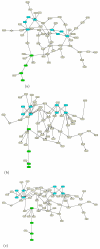



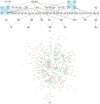
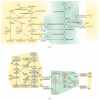
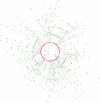
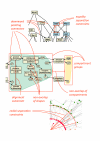
Similar articles
-
An efficient biological pathway layout algorithm combining grid-layout and spring embedder for complicated cellular location information.BMC Bioinformatics. 2010 Jun 18;11:335. doi: 10.1186/1471-2105-11-335. BMC Bioinformatics. 2010. PMID: 20565884 Free PMC article.
-
A new grid- and modularity-based layout algorithm for complex biological networks.PLoS One. 2019 Aug 29;14(8):e0221620. doi: 10.1371/journal.pone.0221620. eCollection 2019. PLoS One. 2019. PMID: 31465473 Free PMC article.
-
An efficient grid layout algorithm for biological networks utilizing various biological attributes.BMC Bioinformatics. 2007 Mar 6;8:76. doi: 10.1186/1471-2105-8-76. BMC Bioinformatics. 2007. PMID: 17338825 Free PMC article.
-
Biological Network Inference and analysis using SEBINI and CABIN.Methods Mol Biol. 2009;541:551-76. doi: 10.1007/978-1-59745-243-4_24. Methods Mol Biol. 2009. PMID: 19381531 Review.
-
Exploiting stoichiometric redundancies for computational efficiency and network reduction.In Silico Biol. 2015;12(1-2):55-67. doi: 10.3233/ISB-140464. In Silico Biol. 2015. PMID: 25547516 Free PMC article. Review.
Cited by
-
Path2Models: large-scale generation of computational models from biochemical pathway maps.BMC Syst Biol. 2013 Nov 1;7:116. doi: 10.1186/1752-0509-7-116. BMC Syst Biol. 2013. PMID: 24180668 Free PMC article.
-
Visualization of omics data for systems biology.Nat Methods. 2010 Mar;7(3 Suppl):S56-68. doi: 10.1038/nmeth.1436. Nat Methods. 2010. PMID: 20195258 Review.
-
Mental-Map Preserving Visualisation of Partitioned Networks in Vanted.J Integr Bioinform. 2019 Jun 14;16(3):20190026. doi: 10.1515/jib-2019-0026. J Integr Bioinform. 2019. PMID: 31199771 Free PMC article.
-
BEL Commons: an environment for exploration and analysis of networks encoded in Biological Expression Language.Database (Oxford). 2018 Jan 1;2018:bay126. doi: 10.1093/database/bay126. Database (Oxford). 2018. PMID: 30576488 Free PMC article.
-
Methods, Tools and Current Perspectives in Proteogenomics.Mol Cell Proteomics. 2017 Jun;16(6):959-981. doi: 10.1074/mcp.MR117.000024. Epub 2017 Apr 29. Mol Cell Proteomics. 2017. PMID: 28456751 Free PMC article. Review.
References
-
- Ehrenberg M, Elf J, Aurell E, Sandberg R, Tegnér J. Systems Biology Is Taking Off. Genome Research. 2003;13:2377–2380. - PubMed
-
- Kitano H. Systems Biology: A Brief Overview. Science. 2002;295(5560):1662–1664. - PubMed
-
- Basalaj W, Eilbeck K. In: Proc. International Symposium on Graph Drawing (GD'99), LNCS. Kratochvil J, editor. Vol. 1731. Stirin Castle: Springer; 1999. Straight-line drawings of protein interactions; pp. 259–266.
-
- Becker MY, Rojas I. A graph layout algorithm for drawing metabolic pathways. Bioinformatics. 2001;17(5):461–467. - PubMed
-
- Genc B, Dogrusöoz U. In: Proc. International Symposium on Graph Drawing (GD'03), LNCS. Liotta G, editor. Vol. 2912. Perugia: Springer; 2003. A Constrained, Force-Directed Layout Algorithm for Biological Pathways; pp. 314–319.
MeSH terms
LinkOut - more resources
Full Text Sources

